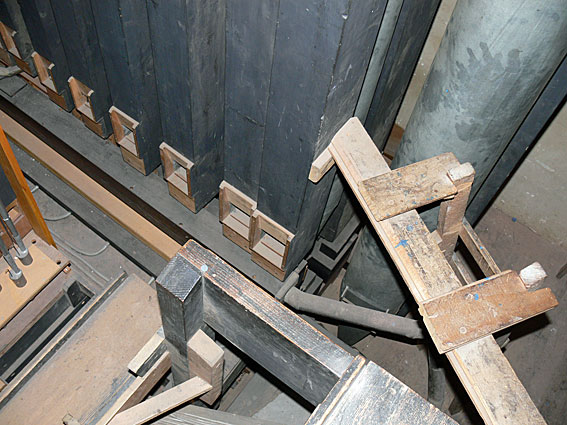Clayton-Wesley Memorial Uniting Church
Norwood (Beulah Park)
J.E. Dodd, Adelaide, 1897 - 2 man., 27 sp. st., 3 c., mech. & tub-pn

Notes by Rev Bruce Naylor "Celebrating 150 years since the birth of J E Dodd" (Aug. 2006):
The first of the great trio of large organs in Adelaide built by Dodd. Not two years after the firm started in 1894 Dodd was asked to put in some specifications for the fashionable Clayton Congregational Church in Norwood. Among the notable people in the congregation was Sir Edwin Smith, sometime Lord Mayor of Adelaide. The specification decided, Sir Edwin Smith was appealed to, and he at once offered half the cost, and later on some additional stops. [1] Thus it was a large organ and it became the largest church organ at that time in the colony. [2]
The wooden harmonic flute on the great and the metal open diapason 16 ft. on the pedal were the only ones of their kind in the colony, and the stop action and pistons on tubular-pneumatic had not been used before. The manual touch was lightened by lever-pneumatic. [3] It had three thumb pistons to great and swell and six hitching pedals which controlled full great, full swell, the tremulant, the tonerre on the swell and the plauvoir on the swell. A clarinet combination stop knob could be drawn for the effect named. The three pedals bringing on the full swell, full great, or full organ worked independently of the stops already drawn, and when the pedals were released the combination in use was restored. This meant that echo combinations could be set and a contrast made by using one of the pedals. The tonerre (thunder) and pleuvoir (rain) combinations have been disconnected, so unfortunately we are not to know what they consisted of. Such devices were not used again, so presumably they were not considered a success. The metal pipes were all imported from England.
The principal stops had larger scales than any diapasons in the colony. Those at the town Hall were 5-1/2" in diameter, but Clayton diapasons are 8". [4] At the opening Mr W Sanders played 'The Storm' of Lefébure-Wely, no doubt assisted by the tonerre and pleuvoir! It was noted that the new instrument came through the ordeal triumphantly, not a hitch occurring in the controlling mechanism or action, and its fine power and the variety and quality of the its registers was universally admired. [5] The cost was £1,000. [6]
Builder: First instrument came from Norwood Baptist Church and the builder was unknown. Fincham removed the second manual and sold the organ to Clayton in 1882. [7] A contradictory account says the organ was bought in 1886 for £150. [8] A new organ costing £1,000 was built by J.E . Dodd in 1897. [9] The original organ was then sold to College Park Congregational Church. [10] (Now in Sunset Rock Uniting Church).
|
Great Organ |
16 8 8 8 8 8 4 4 2 III 8 16 8 8 8 8 4 4 III 8 8 8 8 ) ) ) ) ) ) 16 16 16 8 |
(11 stops) (wood) (11 stops) (1 stop) (the choir plays from the great) in storage (Now replaced by trumpet 8) prepared for (4 stops) (wood) (metal) (wood) |
Compass: 56/30
Great Sesquialtera III:
CC 15,17.19
Mid. C 10.12.15
Swell Mixture III:
CC 15, 19, 22
Mid. C 8, 12, 15
Spotted metal, zinc and wood pipes
tracker and lever pneumatic to manuals, tubular-pneumatic to stops and action
slider soundboards
thumb pistons Great 3, Swell 3
clarinet combination worked by a drawknob
six hitching pedals - full swell, full great, full organ, tremulant, tonerre on the swell, pleuvoir on the swell.
balanced swell pedal
attached console
drawknobs
east wall chamber
excellent acoustics
space allowed in chamber between great and swell chests for a choir soundboard.
1. Music, July 1897, 11b and 12a.
2. Register, 5 July 1897, 6g.
3. Register, 5 July 189, 6d.
4. Music, July 1897, 11b and 12a.
5. Music, October 1897, lla.
6. Clayton Jubilee Record, 1906, 13.
7. News, untraced reference.
8. Matthews, 195.
9. Clayton Jubilee Record, 1906, 13.
10. Clayton Centenary, 1854-1954, 2.











Photos: JRM